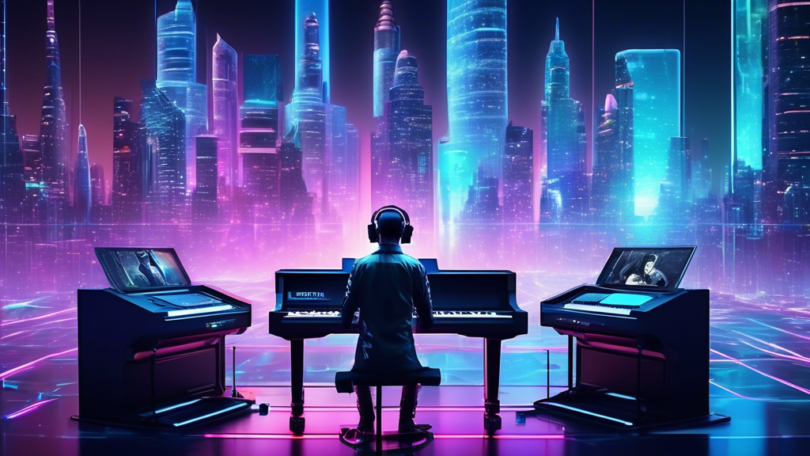Revolutionizing Sync Licensing with AI: The Future of Music and Media
The sync licensing landscape has undergone a significant transformation over the years, with the integration of Artificial Intelligence (AI) marking a pivotal point in its evolution. Traditionally, sync licensing—the process of pairing music with visual media such as films, TV shows, advertisements, and video games—has been a labor-intensive and time-consuming task, often reliant on the subjective judgment of human professionals.
In recent times, however, AI innovations have begun to reshape how sync licensing is approached. By leveraging advanced algorithms and machine learning techniques, AI is enhancing the efficiency, accuracy, and scalability of this process. This revolutionary technology is not only streamlining operations but also opening new avenues for music discovery and matching, ensuring that the perfect piece of music finds its ideal media partner.
This article delves into the dichotomy between traditional sync licensing methods and the emerging AI-driven solutions. We will explore how AI is redefining music and media synchronization, from improving search mechanisms to delivering unprecedented match accuracy. Additionally, we will look ahead to the future, contemplating the broader implications of AI integration in the sync licensing ecosystem and its long-term impact on the music and media industries.
The Evolution of Sync Licensing: Traditional Methods vs. AI Innovations
Overview of Traditional Sync Licensing Processes
Sync licensing, the process of synchronizing music with visual media like film, television, advertisements, and video games, has traditionally been a complex and manual endeavor. Historically, this involved painstaking manual efforts by music supervisors and licensing agents to find and select the most suitable track from a vast array of songs. These professionals had to navigate through numerous catalogs, deal with complex rights management, and negotiate licensing fees with various stakeholders. This traditional approach is not only time-consuming but also relies heavily on the human element, which can lead to subjective decision-making and inefficiencies.
In the traditional model, music supervisors often collaborate directly with artists, record labels, and music publishers to secure the necessary rights. The process involves multiple steps, such as identifying potential tracks, seeking approvals, and negotiating terms and conditions. Given the complicated nature of music rights, including mechanical, performance, and synchronization rights, this procedure can frequently face delays and legal pitfalls. Furthermore, the administrative burdens associated with managing licensing agreements, tracking usage, and ensuring proper compensation can overwhelm even seasoned professionals.
Introduction to the Role of AI in Sync Licensing
The advent of artificial intelligence (AI) has brought a revolutionary shift in the sync licensing space. AI in sync licensing leverages advanced algorithms and machine learning to streamline the entire process, reducing the reliance on human labor and minimizing subjectivity. AI technologies analyze vast datasets, including audio properties, lyrics, and contextual metadata, to match the perfect track with the right piece of visual media.
AI-driven platforms use natural language processing (NLP) and pattern recognition to analyze music tracks comprehensively. These platforms can ingest an immense volume of data, including audio files, metadata, and even user preferences, to identify optimal sync matches in a fraction of the time it would take a human. Additionally, AI can learn and adapt over time, improving its recommendations and increasing its effectiveness with each sync opportunity it processes. This automated approach not only speeds up the licensing process but also increases the accuracy and relevance of music matches, providing a significant advantage over traditional methods.
Comparative Analysis: Efficiency, Accuracy, and Scalability Improvements Brought by AI
When comparing traditional sync licensing methods to AI innovations, several key improvements emerge, particularly in terms of efficiency, accuracy, and scalability.
Efficiency
Traditional sync licensing is labor-intensive, often requiring weeks or even months to finalize a deal. AI, on the other hand, significantly enhances efficiency by automating many of the laborious tasks involved. AI algorithms can swiftly scan thousands of tracks, perform contextual analyses, and generate potential matches almost instantaneously. This accelerated efficiency enables faster turnaround times for projects, which is invaluable in today’s rapidly evolving media landscape.
Accuracy
Human curators are prone to biases and limitations in their musical knowledge and preferences. AI innovations mitigate these drawbacks by employing objective criteria based on a comprehensive analysis of audio features, lyrical content, and emotional tone. AI can also consider contextual factors such as scene dynamics and audience demographics, ensuring higher accuracy in the sync matching process. Consequently, AI-driven sync licensing achieves more precise and contextually appropriate music selections, enhancing the overall impact of the media.
Scalability
One of the most notable advantages of AI in sync licensing is its scalability. Traditional methods are inherently limited by human resource constraints, making it difficult to handle large volumes of licensing requests simultaneously. AI technology, however, can effortlessly scale to accommodate a vast number of projects across different media platforms. This scalability is especially crucial as the demand for multimedia content continues to grow, necessitating efficient and effective sync licensing solutions.
In conclusion, the evolution of sync licensing from traditional methods to AI innovations marks a significant leap forward for the music and media industries. AI enhances efficiency, improves accuracy, and offers unparalleled scalability, making it an essential tool for modern sync licensing. As AI continues to evolve and integrate into the industry, it holds the promise of transforming the landscape, benefiting artists, media producers, and licensing agencies alike.
How AI in Sync Licensing Enhances Music Discovery and Matching
Mechanisms of AI-Driven Music and Media Analysis
AI in sync licensing leverages advanced algorithms and machine learning to conduct detailed analyses of both music and media content. This process begins with the AI’s capability to break down a song into various components such as tempo, mood, instrumentation, and even lyrical themes. Similarly, media content can be dissected into elements like pacing, emotional trajectory, and visual themes. By indexing these detailed features, AI can create a robust database that links specific musical qualities with media needs.
Machine learning models are trained on vast datasets that include successful past sync licenses, which enables AI to understand and predict what combinations of music and media work well together. Through pattern recognition, AI algorithms can suggest music tracks that efficaciously enhance the narrative and emotional context of a given piece of media.
AI is also capable of real-time adjustments. As media producers make changes to their projects, AI systems can instantly analyze these adjustments and recommend suitable music alterations. This dynamic adaptability surpasses the traditional static methods of music discovery and matching, allowing for a more seamless and intuitive integration of audio and visual elements.
Case Studies Showcasing AI’s Success in Identifying Perfect Sync Matches
Various success stories emphasize the transformative potential of AI in sync licensing. For example, a popular streaming service utilized an AI-driven sync licensing platform to find a fitting soundtrack for a highly-anticipated drama series. By analyzing the show’s intricate plot lines, character developments, and the overall atmospheric tone, the AI system proposed a selection of songs that perfectly complemented each episode. This not only saved time but also significantly enhanced the viewing experience for audiences, leading to higher viewer engagement and critical acclaim.
In another case, a major advertising company leveraged AI to find music for their latest commercial campaign. The AI system evaluated the brand’s core message, target audience, and the commercial’s visual style. It then matched these elements with a database of musical compositions, recommending tracks that would resonate well with viewers and amplify the campaign’s impact. The results were impressive: not only did the commercial achieve a high recall rate, but it also saw increased conversions for the advertised product.
Independent artists have also benefited immensely from AI in sync licensing. By utilizing AI platforms, emerging musicians have found new avenues to showcase their work in films, TV shows, and advertisements. The exposure helps these artists grow their audiences and opens up new revenue streams, demonstrating the symbiotic benefits of AI for all stakeholders in the sync licensing process.
Benefits for Artists, Media Producers, and Licensing Agencies
AI in sync licensing results in numerous advantages for artists, media producers, and licensing agencies. For artists, AI simplifies the process of getting their music discovered and licensed by potential clients. AI systems ensure that tracks are accurately categorized and indexed based on their unique attributes, thereby significantly increasing the chances of a match with suitable media content.
Media producers immensely benefit from AI’s precision in identifying music that aligns perfectly with their projects. Traditional manual searches are often time-consuming and laborious, but AI can swiftly sift through massive music libraries to present producers with the most relevant options. This efficiency not only cuts down on production time but also reduces costs associated with prolonged search efforts and licensing negotiations.
Licensing agencies find AI to be an invaluable tool for managing and monetizing their music catalogs. AI-enhanced platforms provide deep insights and analytics about trends, usage patterns, and the performance of various tracks. This data allows agencies to optimize their marketing strategies and project potential licensing opportunities. Moreover, AI’s ability to automate routine tasks such as compliance checks and contract preparations frees up human resources, allowing for a greater focus on strategic growth and client relations.
Another significant advantage is AI’s ability to democratize the sync licensing industry. By offering a transparent and data-driven approach, AI ensures that even lesser-known artists have an equal opportunity to have their music considered for high-profile media projects. This inclusivity fosters creativity and diversity within the music and media landscape, enriching the overall quality and variety of content available to audiences.
In essence, AI in sync licensing stands as a game-changer, revolutionizing how music discoveries are made and matched to media content. The efficiency, accuracy, and scalability offered by AI bring a host of benefits, driving innovation, and success across the entire spectrum of the music and media industries.
The Future Landscape: AI Transforming the Sync Licensing Ecosystem
Predictions for Industry-Wide Adoption of AI in Sync Licensing
As artificial intelligence continues to permeate various industrial sectors, the sync licensing ecosystem is poised for a transformative evolution. The traditional methods of processing and matching music with media are gradually being overshadowed by the unparalleled capabilities of AI in sync licensing. With a growing number of industry players recognizing the immense benefits of AI, it is anticipated that within the next decade, AI-driven solutions will become the gold standard in sync licensing operations.
AI’s ability to analyze vast datasets rapidly and match music with visual content effectively is a game-changer. As more licensing agencies and media producers embrace AI technologies, we expect to see a seamless integration of AI tools into their workflows. This widespread adoption is likely to revolutionize music discovery and sync matching processes, potentially leading to new business models and revenue streams within the industry.
Potential Challenges and Solutions in Integrating AI Technology
Despite the promising prospects, the integration of AI in sync licensing is not without its challenges. One of the primary concerns is the resistance to change among industry professionals who are accustomed to traditional methods. This cultural shift necessitates comprehensive training programs to help stakeholders understand and utilize AI technologies effectively.
Another significant hurdle is the initial investment required for AI implementation. However, as AI solutions become more mainstream, the costs are expected to decrease, making it more accessible for smaller enterprises. Additionally, partnerships between tech companies and music industry stakeholders could facilitate a smoother transition by providing affordable AI-driven tools and platforms.
Data privacy and intellectual property rights also present challenges in the adoption of AI. Ensuring that AI algorithms respect copyright laws and safeguard sensitive data is paramount. The development of robust regulatory frameworks and ethical guidelines will be crucial in addressing these concerns. By fostering a collaborative environment among tech developers, legal experts, and industry professionals, the sync licensing landscape can navigate these challenges to harness the full potential of AI innovations.
The Long-Term Impact on Music and Media Industries
AI in sync licensing is set to have a profound long-term impact on both the music and media industries. For artists, the enhanced music discovery features powered by AI can lead to increased exposure and new opportunities. AI algorithms can meticulously analyze musical elements and match them with optimal media placements, thereby ensuring that artists’ work reaches its intended audience with greater precision.
For media producers, AI offers a streamlined process for finding the perfect soundtrack that resonates with their visual content. This not only enhances the quality and emotional impact of media projects but also significantly reduces the time and resources traditionally spent on music curation. The efficiency provided by AI allows for more creative freedom and quicker turnaround times, ultimately boosting productivity and innovation within the industry.
The ripple effect of AI’s integration extends to licensing agencies as well. AI tools can automate and optimize various aspects of the licensing process, from rights management to royalty tracking, leading to improved accuracy and transparency. This, in turn, builds trust and enhances relationships between artists, producers, and agencies.
In conclusion, the future of AI in sync licensing is promising, with the potential to revolutionize the way music and media intersect. While challenges exist, the long-term benefits for the music and media industries are substantial. By embracing AI technologies, the sync licensing ecosystem can achieve unprecedented levels of efficiency, creativity, and profitability, heralding a new era of innovation and collaboration.
The Future of AI in Sync Licensing: A Transformative Journey Ahead
As we delve into the extraordinary advancements AI brings to sync licensing, it is clear that we are at the threshold of a transformative era for the music and media industries. The integration of AI in sync licensing is not just a fleeting trend but a fundamental shift that is poised to redefine how music and media content are paired and delivered to audiences.
Innovation and Industry Adoption
AI in sync licensing promises to revolutionize the industry by making the process faster, more efficient, and remarkably precise. As more companies recognize the advantages, widespread industry adoption is inevitable. The ability to swiftly analyze vast libraries of music and media to find the perfect match can not only save time but also reduce costs, making it an attractive proposition for all stakeholders involved.
Addressing Challenges
Despite the promising outlook, integrating AI in sync licensing does come with its own set of challenges. These include ensuring the ethical use of AI, safeguarding intellectual property, and maintaining a balance between human creativity and machine efficiency. However, by developing robust frameworks and protocols, these challenges can be effectively managed, paving the way for a seamless transition to a more technologically advanced ecosystem.
Long-term Impact on the Industry
In the long run, the influence of AI in sync licensing will be profound. It will democratize access to sync opportunities for independent artists, streamline the workflow for media producers, and enable licensing agencies to offer more competitive and comprehensive services. Moreover, by enhancing the quality and relevance of music-media pairings, AI will contribute to richer, more engaging audience experiences.
The transformative potential of AI in sync licensing is immense. By embracing this change, the music and media industries stand to benefit from unprecedented efficiencies, improved accuracy, and scalable solutions that can adapt to the ever-evolving digital landscape. As we look to the future, one thing is certain: AI is not just an innovation in sync licensing; it is the future.
Live Sync Music Updates 24/7 On X








